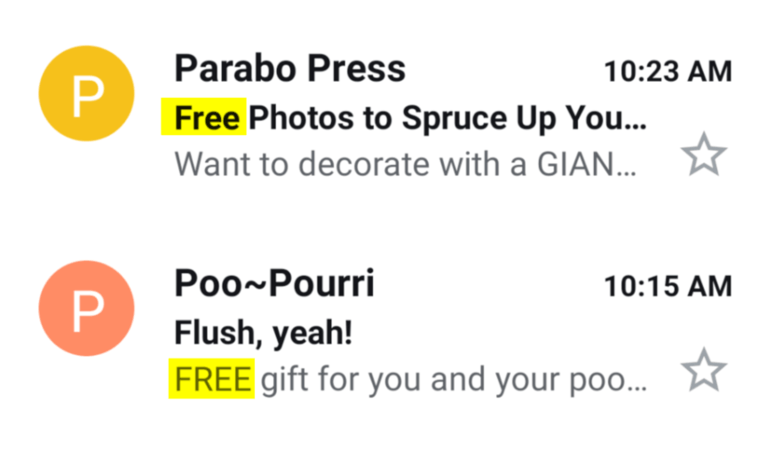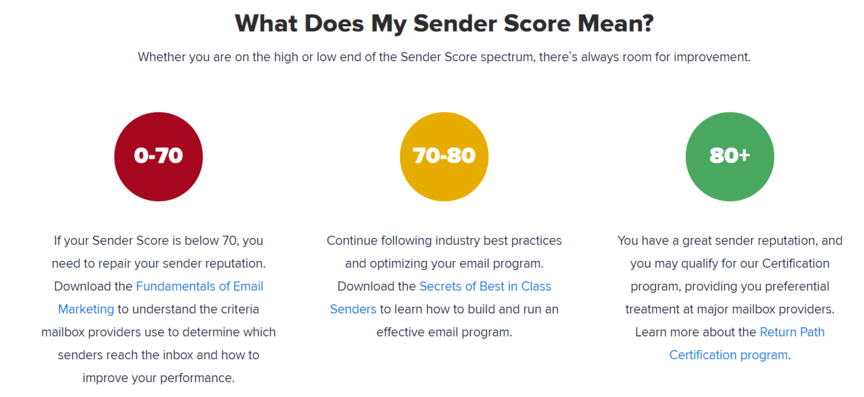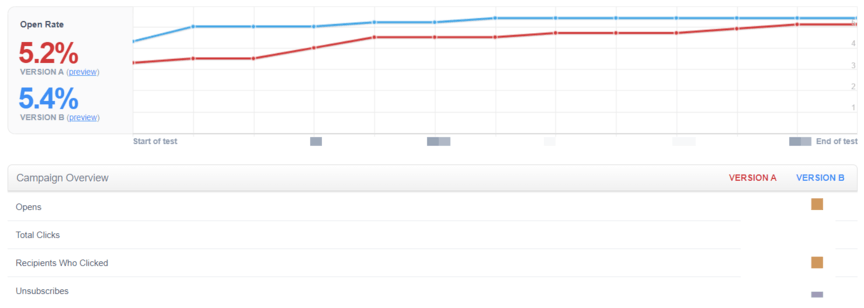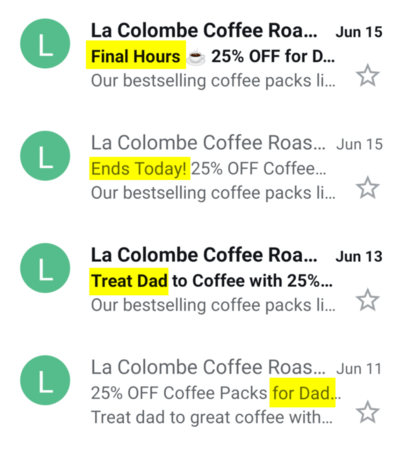-
 9 min. read
9 min. read
-
 Sarah Berry
Sarah Berry Web Marketing Consultant
Web Marketing Consultant
- Sarah Berry is a Google Analytics-certified Web Marketing Consultant at WebFX. She’s written over 400 articles on digital marketing, covering topics like SEO, CRO, and Amazon. When she isn’t polishing her Time Magazine Person of the Year Award, she’s spending time with her flock of ducks.
What do the jackalope, phoenix, and unicorn have in common? They’re all mythical creatures. Much like the animal kingdom, the email marketing world also has its own set of myths.
Instead of mythical creatures, though, it’s mythical practices that supposedly deliver the best results — no matter the business, product, or subscriber. The seven most rampant email marketing myths (that even non-gullible people believe) include:
- Tuesday is the best day to send emails
- Emails with the word “free” get marked as spam
- Short subject lines perform best
- Unsubscribes translate to bad email marketing
- 4 p.m. is the best time to send emails
- Sending too many emails kills email marketing campaigns
- Email marketing is dead
Keep reading to get all the details on these myths about email marketing, including why they’re false. For more email marketing, as well as digital marketing tips, subscribe to Revenue Weekly — a trusted resource for more than 200,000! Want to watch us bust some general digital marketing myths?
Check out the video below!
1. Tuesday is the best day to send emails
Search for the best day to send emails, and even Google will reveal this email marketing myth. The search engine compiles results that credit various days of the week as the best day, including:
- Tuesday
- Thursday
- Saturday
Of course, email marketers aren’t recommending these days without reason. Almost all base their recommendations on different studies and data points — and that’s fantastic. The problem is that these recommendations become fact for businesses getting started with email marketing.
While you can use Tuesday, Thursday, or another recommended day as your starting point, you want to test different days. Your business, industry, product or service, subscriber, and email content are unique. What you’re offering and who you’re offering it to may result in a top-performing send day that doesn’t match the email marketing world’s recommendation.
That’s why it’s critical to test your send days and use your data to determine the best send day for your business. If you don’t test, you’ll never know, which can hold back your entire email marketing strategy.
2. Emails with the word “free” get marked as spam
While once true, this email marketing best practice went extinct a while ago. In the past, you needed to worry about your word choice, like for your subject lines, because certain words could send your emails straight to the spam box. While people do check their spam folder, occupying that folder doesn’t lead to the greatest engagement rates.
A few examples of words that would trigger spam filters include:
- Free
- Affordable
- Buy
- Clearance
- Earn
- Lowest price
Since the days of dial-up Internet, though, spam filters have evolved, becoming much more sophisticated and capable of separating a spam email from a promotional email. Unfortunately, this email marketing myth remains popular.  If your business still believes this myth about email marketing, retire it.
If your business still believes this myth about email marketing, retire it.
Go ahead and use these terms (if accurate) to describe your email. If you’re providing free shipping for a limited time, for instance, incorporate that offer into your subject line. “Free” describes your offer, and spam filters should detect that your email isn’t spam.
If you still have some worries over ending up in the spam inbox, check your company’s sender reputation with a free tool like Sender Score.  This tool will evaluate the reputation and trustworthiness of your business (on a scale of 0-80+) as an email sender. A higher score translates to a higher level of trustworthiness as an email sender.
This tool will evaluate the reputation and trustworthiness of your business (on a scale of 0-80+) as an email sender. A higher score translates to a higher level of trustworthiness as an email sender.
If you have a low score, Sender Score offers various resources for how to improve your score.
3. Short subject lines perform best
Your subject line is your gateway to getting subscribers to open your email and act on your offer inside. That’s why a lot of people ask, “What is the best length for email subject lines?” and a lot of people respond, “The shorter, the better.” Shorter, though, is not always better. While most studies point to 41 characters (or seven words) as the optimal subject line length, many mention that your optimal subject line will depend on factors related to your business, like your brand, products or services, audience, and more.
Again, like the best day to send email marketing myth, you want to test. Test different lengths, whether by word or character count, for your emails and see what happens. With email management programs like EmailMarketingFX, you can A/B test your subject lines.
With email A/B testing, you send two variations of your email to two subscriber subsets, those in your “A” test group and those in your “B” test group.  A/B testing can help you uncover the ideal length for your subject lines. You can also discover words, phrases, or angles that work well with your subscribers, which can lead to more opens, clicks, and conversions across your email marketing campaign.
A/B testing can help you uncover the ideal length for your subject lines. You can also discover words, phrases, or angles that work well with your subscribers, which can lead to more opens, clicks, and conversions across your email marketing campaign.
4. Unsubscribes translate to bad email marketing
Much like dropping your ice cream cone on the sidewalk, seeing unsubscribes can make you sad. This email marketing myth is easy to adopt as truth. The truth, however, is that unsubscribes aren’t always a bad sign.
Most of the time, an unsubscribe serves as a signal that unqualified users, or people who aren’t your ideal shopper or client, recognize they’re not a good fit. A software company that offers enterprise-level solutions, for instance, may see unsubscribes from users that realize your business provides software that far exceeds their current needs, so it doesn’t make sense to continue receiving sales communications from you. It doesn’t make sense for you to continue sending them emails, either.
You pay to send those emails, and if that person works at a start-up, they probably won’t need your services for years. If they do need your services in the future, they’ll likely re-enter the buying funnel — and if you’ve kept up your marketing initiatives — find you and your email campaign again.
The average unsubscribe rate is below two percent, so if yours exceeds two percent, look into it.
Like many of the myths about email marketing on this list, you shouldn’t ignore this myth completely. The average unsubscribe rate is below two percent, so if yours exceeds two percent, look into it.
Factors like email send frequency, content, and audience segmentation can all result in users unsubscribing, even if they’re qualified. Create valuable emails targeted to your audience segments, and you’ll likely see a low unsubscribe rate.
5. 4 p.m. is the best time to send emails
Sending your promotional emails at four o’clock in the afternoon may work wonders for your business. Your informational emails, however, may struggle to get opens during that time.
That’s why it’s essential to test your send times. Experimenting with your send times can help your company achieve the best engagement rates, as well as get the most value from your different email campaigns, like for promotions, lead nurturing, and client retention. Use the industry’s recommended time, 4 p.m., as a baseline for your test efforts.
See if you can achieve better engagement rates consistently at the time or another time for an email campaign. If you find a time that’s better than 4 p.m., try another time and see if you can discover an even better send time. Keep in mind that your send day, like Tuesday, can also influence the results of your send time tests.
6. Sending too many emails kills email marketing campaigns
When it comes to email marketing myths, it’s easy to believe that sending too many emails can ruin your email marketing campaign — because it happens. In some cases, businesses go too far and spam users with emails that offer little value. Your company, however, can send frequent emails successfully if you ensure they provide value.
An ecommerce store offering a holiday sale, for instance, will likely benefit from sending multiple emails promoting the sale. Those emails remind shoppers about the offer and provide them quick access to the sale.  How often you send emails will depend on factors specific to your business, like your:
How often you send emails will depend on factors specific to your business, like your:
- Industry
- Email goals
- Subscribers
- Products or services
If you’re thinking about increasing your email send frequency, ask these questions:
- How often do we want to send emails?
- Do we have any past data on this send frequency?
- What is our audience looking to get from our emails?
- How will these emails deliver on audience expectations?
Answering these questions will help your business remember your audience and ensure you deliver on their expectations. Forget about your subscribers, and you risk adopting an email frequency that annihilates your subscriber list.
7. Email marketing is dead
This myth about email marketing is a popular one because email marketing doesn’t always work. When email marketing doesn’t work, it’s often because of the strategy, not the channel. Companies purchase subscriber lists, for example, to boost their numbers or spam subscribers with emails that beg readers to buy.
If your business’s email marketing strategy isn’t delivering, conduct an audit and look at the following:
- Your email marketing goals
- Your email marketing campaigns
- Your subscriber lists
- Your send day and time
- Your content
A few common ways that companies can improve their email marketing strategy include:
- Segmenting subscribers into different subscriber sets
- A/B testing email send times, subject lines, and content
- Updating content to better match subscriber expectations
- Creating an opt-in strategy to attract more qualified subscribers
- Adding a call to action (CTA) to all emails
If you still aren’t seeing results from your email marketing campaigns after making changes, you may want to consider talking with an email marketing agency, like WebFX. We can look at your strategy and campaigns, and provide actionable advice for getting better results.
Get started on your email marketing campaign (without these email marketing myths)
Email is a powerful strategy for attracting, nurturing, and converting leads, as well as generating repeat purchases and reducing client churn. That’s why it’s smart to have an email marketing strategy.
It can give your business a competitive advantage and the chance to drive more revenue. So, get started with your email marketing campaign — minus these email marketing myths! If you’re looking for some professional help, guidance, or management for your email marketing strategy, WebFX can help.
Contact us online or call us at 888-601-5359 to learn more about our email marketing management services!
-
 Sarah Berry is a Google Analytics-certified Web Marketing Consultant at WebFX. She’s written over 400 articles on digital marketing, covering topics like SEO, CRO, and Amazon. When she isn’t polishing her Time Magazine Person of the Year Award, she’s spending time with her flock of ducks.
Sarah Berry is a Google Analytics-certified Web Marketing Consultant at WebFX. She’s written over 400 articles on digital marketing, covering topics like SEO, CRO, and Amazon. When she isn’t polishing her Time Magazine Person of the Year Award, she’s spending time with her flock of ducks. -

WebFX is a full-service marketing agency with 1,100+ client reviews and a 4.9-star rating on Clutch! Find out how our expert team and revenue-accelerating tech can drive results for you! Learn more
Try our free Marketing Calculator
Craft a tailored online marketing strategy! Utilize our free Internet marketing calculator for a custom plan based on your location, reach, timeframe, and budget.
Plan Your Marketing Budget
Table of Contents
- 1. Tuesday is the Best Day to Send Emails
- 2. Emails with the Word “free” Get Marked As Spam
- 3. Short Subject Lines Perform Best
- 4. Unsubscribes Translate to Bad Email Marketing
- 5. 4 P.m. is the Best Time to Send Emails
- 6. Sending Too Many Emails Kills Email Marketing Campaigns
- 7. Email Marketing is Dead
- Get Started on Your Email Marketing Campaign (without These Email Marketing Myths)

Maximize Your Marketing ROI
Claim your free eBook packed with proven strategies to boost your marketing efforts.
Get the GuideTry our free Marketing Calculator
Craft a tailored online marketing strategy! Utilize our free Internet marketing calculator for a custom plan based on your location, reach, timeframe, and budget.
Plan Your Marketing Budget





